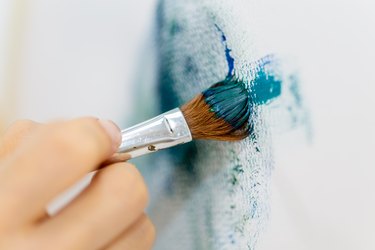
Acrylic paint is water-soluble when it is still wet, but after it's dry, it can only be removed from canvases and other surfaces with a solvent. Whether you want to correct a painting mistake or strip an entire canvas for reuse, the task is somewhat tricky and doesn't promise perfect results. With an appropriate solvent and the right techniques, you can usually remove dried acrylic paint from a canvas with success, but understand that some staining is likely to remain. Also, be aware that safety precautions are necessary when using chemical solvents.
Select a Solvent
Video of the Day
Solvents that are most commonly used to strip acrylic paint from a canvas include turpentine, mineral spirits and rubbing alcohol. These are all readily available and inexpensive household products. Another option suitable for spot removal is hand sanitizer (choose an aloe-free formula). There are also some artist-grade solvents formulated specifically for paint removal, which you might be able to find at an art supply store.
Video of the Day
No matter which of these solvents you choose, be sure to work in a well-ventilated area, preferably outside and away from any open flames or heat sources. Wear protective gloves and glasses.
Spot Cleaning Acrylic Paint
If you made a mistake while painting on a canvas with acrylic paint and painting over the mistake is not an option, it's possible to spot clean just one area with a solvent. Soak a clean, soft rag, a cotton ball or the end of a cotton swab with a solvent and use it to soak the area of paint you wish to remove. Alternatively, squeeze aloe-free hand sanitizer over the area of paint.
Let the solvent sit on the paint for approximately 30 minutes and then scrape off the softened paint with a putty knife or an old toothbrush. Wipe the scraped-off area with the rag, cotton ball or swab to remove any remaining traces of paint. If necessary, repeat the process until you've removed as much paint as possible.
Stripping an Entire Canvas
To remove all the paint from a canvas, you need to soak the whole canvas in a solvent. Find a container large enough to contain the flat canvas, such as a wash basin or storage container. Pour enough solvent into the container to reach approximately 1 inch up the sides and then place the canvas with the painted side facing down into the solvent. Let the canvas soak in the solvent for up to one hour.
Remove the canvas and scrape off as much of the softened paint as you can with a putty knife or old dish brush. Wipe away any remaining traces of paint with a soft rag. You might need to repeat the process if paint still remains on the canvas. Finally, scrub the canvas clean with a mixture of hot water and dish soap using a dish brush or rag and let the canvas air dry.
Reprime the Canvas
Stripping a canvas with solvents is likely to remove the layers of gesso that were originally applied to prime it. Reprime the canvas by painting three or four coats of white gesso over it with a wide paintbrush. Allow each coat of gesso to dry before applying the next one and change the direction of the brushstrokes for each coat.
Consider an Alternative Method
If you want to strip acrylic paint from a canvas for the purpose of reusing it, know that there's an alternative method that doesn't require solvents and is often just as effective. Sand down the layers of unwanted acrylic paint with fine-grit sandpaper until the canvas feels smooth. Paint as many layers of white gesso as it takes to cover the remaining paint. With a high-quality gesso, you should be able to cover even dark acrylic paint with just three or four coats.